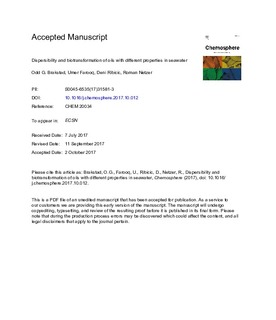| dc.contributor.author | Brakstad, Odd Gunnar | |
| dc.contributor.author | Farooq, Umer | |
| dc.contributor.author | Ribicic, Deni | |
| dc.contributor.author | Netzer, Roman | |
| dc.date.accessioned | 2018-05-15T16:22:03Z | |
| dc.date.available | 2018-05-15T16:22:03Z | |
| dc.date.created | 2017-10-12T14:56:45Z | |
| dc.date.issued | 2018-01 | |
| dc.identifier.citation | Chemosphere. 2018, 191 44-53. | nb_NO |
| dc.identifier.issn | 0045-6535 | |
| dc.identifier.uri | http://hdl.handle.net/11250/2498230 | |
| dc.description.abstract | Dispersants are used to remove oils slicks from sea surfaces and to generate small oil-droplet dispersions, which may result in enhanced biodegradation of the oil. In this study, dispersibility and biodegradation of chemically dispersed oils with different physical-chemical properties (paraffinic, naphthenic and asphaltenic oils) were compared in natural temperate SW at 13 °C. All selected oils were chemically dispersible when well-known commercial dispersants were used. However, interfacial tension (IFT) studies of the dispersed oils showed different IFT properties of the oils at 13 °C, and also different leaching of the dispersants from oil droplet surfaces. Biodegradation studies of the chemically dispersed oils were performed in a carousel system, with initial median droplet sizes <30 μm and oil concentrations of 2.5–2.8 mg/L. During biodegradation, oil droplet concentrations were rapidly reduced, in association with the emergence of macroscopic 'flocs'. Biotransformation results showed that half-lives of semivolatile total extractable organic carbon (TEOC), single target 2- to 4-ring PAH, and 22 oil compound groups used as input data in the oil spill contingency model OSCAR, did not differ significantly between the oils (P > 0.05), while n-alkanes half-lives differed significantly (P < 0.05). Biotransformation was associated with rapid microbial growth in all oil dispersions, in association with n-alkane and PAH biotransformation. These results have implications for the predictions of biodegradation of oil slicks treated with dispersants in temperate SW. | nb_NO |
| dc.description.abstract | Dispersibility and biotransformation of oils with different properties in seawater | nb_NO |
| dc.language.iso | eng | nb_NO |
| dc.rights | Attribution-NonCommercial-NoDerivatives 4.0 Internasjonal | * |
| dc.rights.uri | http://creativecommons.org/licenses/by-nc-nd/4.0/deed.no | * |
| dc.subject | Oil | nb_NO |
| dc.subject | Dispersants | nb_NO |
| dc.subject | Dispersibility | nb_NO |
| dc.subject | Biodegradation | nb_NO |
| dc.subject | Seawater | nb_NO |
| dc.title | Dispersibility and biotransformation of oils with different properties in seawater | nb_NO |
| dc.title.alternative | Dispersibility and biotransformation of oils with different properties in seawater | nb_NO |
| dc.type | Journal article | nb_NO |
| dc.type | Peer reviewed | nb_NO |
| dc.description.version | acceptedVersion | nb_NO |
| dc.rights.holder | © 2017 Elsevier Ltd. All rights reserved. - accepted manuscript © the author(s) 2018 | nb_NO |
| dc.subject.nsi | VDP::Miljøteknologi: 610 | nb_NO |
| dc.subject.nsi | VDP::Environmental engineering: 610 | nb_NO |
| dc.source.pagenumber | 44-53 | nb_NO |
| dc.source.volume | 191 | nb_NO |
| dc.source.journal | Chemosphere | nb_NO |
| dc.identifier.doi | 10.1016/j.chemosphere.2017.10.012 | |
| dc.identifier.cristin | 1504242 | |
| cristin.unitcode | 7566,6,0,0 | |
| cristin.unitname | Miljøteknologi | |
| cristin.ispublished | true | |
| cristin.fulltext | postprint | |
| cristin.qualitycode | 1 | |

